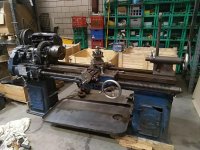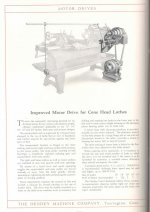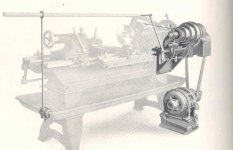Hi everybody. This is my first post, I've been reading a lot on this forum and it's been very helpful. Thank you all for contributing so generously.
I recently picked up a vintage lathe which was somebody else's unfinished project - this meant that half of the parts were scattered in a crate with nothing to identify them. I have struggled to find much information about the lathe, and from what I read over at lathes.co.uk Archdale stopped making lathes in 1915. I wasn't really intending to dive into a full restoration project, I really just wanted a cheap lathe that I could get turning quickly. But the idea of running a 100+year old machine is pretty cool, so I'm going to crack on and finish the rebuild. It is mostly complete but I have a couple of questions that I hope somebody here can help with.
Firstly, within the headstock gearbox, the shafts have these split rings hanging loose on each end. I can't work out what they are for. There is no groove for them to fit into on either the shaft or the housing. I was wondering if they are to hold an oil seal or something like that?

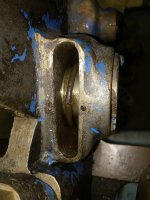
I am also unsure how to judge the oil level in the gearbox. There is no sightglass, and so I imagined that there might be a plug like in the diff of a car, you fill the oil until it overflows from that point. But I can't find any such plug. One theory: there is a cute little lid that you can remove at the back end of the spindle, inside the casting is a scribed line.... maybe this is the oil fill level? I've attached some photos for reference.
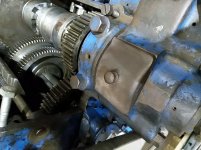
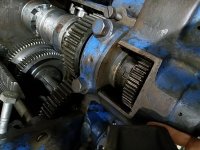

Thanks,
-Dale
I recently picked up a vintage lathe which was somebody else's unfinished project - this meant that half of the parts were scattered in a crate with nothing to identify them. I have struggled to find much information about the lathe, and from what I read over at lathes.co.uk Archdale stopped making lathes in 1915. I wasn't really intending to dive into a full restoration project, I really just wanted a cheap lathe that I could get turning quickly. But the idea of running a 100+year old machine is pretty cool, so I'm going to crack on and finish the rebuild. It is mostly complete but I have a couple of questions that I hope somebody here can help with.
Firstly, within the headstock gearbox, the shafts have these split rings hanging loose on each end. I can't work out what they are for. There is no groove for them to fit into on either the shaft or the housing. I was wondering if they are to hold an oil seal or something like that?


I am also unsure how to judge the oil level in the gearbox. There is no sightglass, and so I imagined that there might be a plug like in the diff of a car, you fill the oil until it overflows from that point. But I can't find any such plug. One theory: there is a cute little lid that you can remove at the back end of the spindle, inside the casting is a scribed line.... maybe this is the oil fill level? I've attached some photos for reference.



Thanks,
-Dale


